[Note: The photos below are a mixture of ones taken by me or my family (not all on this particular trip), or taken from various locations on the Internet.]
We flew into Ciampino, and our route took us over Rome. As it was daylight, and I had the window seat, I could make out the Victor Emmanuel Monument (the "Typewriter", as it is known), and the Colosseum as we came in. I got a bit excited over seeing a train, much to Kate's chagrin, but rather more excited about the aerial views of the aqueducts approaching Rome from the south. The first thing I saw (though I didn't know it at the time) was the sixteenth-century Aqua Felix, which follows the course of the first century AD Aqua Claudia. And then I saw the more impressive remains of the actual Aqua Claudia. I saw a few more arches of the latter on the coach journey up to central Rome.
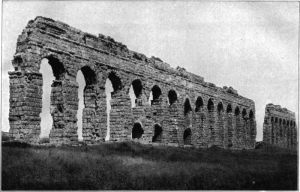
Aqua Claudia.
It was getting dark by the time we actually arrived in Rome, but I could still see enough to note where we came through the third-century AD Aurelian Wall, at Porta Tiburtina (Porta S. Lorenzo), where a monumental arch of Augustus took three aqueducts over the road.
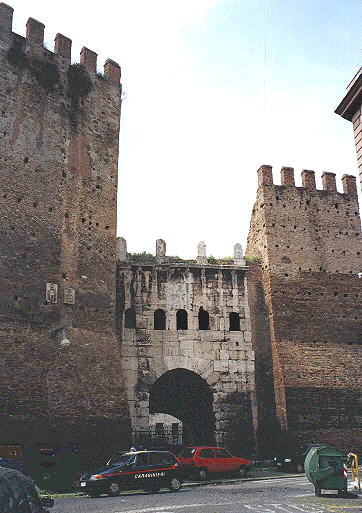
Porta Tiburtina.
The coach then ran up the inside of the wall, which had lots of "Keep off" signs, as this bit is in the grounds of the Ministero della Difesa Aeronautica. Just beyond the Ministry is its ancient equivalent, the camp of the Praetorian Guard, though this can only be detected from the change of direction of the walls.
After that, we were deposited at Roma Termini station, from where we got a modern, clean, but unpunctual, train to Trastevere, booked into our hotel, and joined the rest of the family for pizza.
Sunday was the day of the Baptism. We were bussed out to the institute where the priest are trained, and had the ceremony. I found this fascinating. I always tell my students that the prime difference between Roman religion and Christianity is that in the latter, it is what you believe that matters most, whereas in the former, belief is unimportant, as long as you get the ritual correct. I still think that's true, but much of the belief in the importance of ritual has carried over into Roman Catholic practice - there's a considerable weight placed on getting every act of the ceremony just right.
After this was over, we went to the adjacent Basilica of San Paolo fuori le Mura (St Paul Outside the Walls) for a bit of sightseeing; Kate sat this out in the bus, being quite tired.
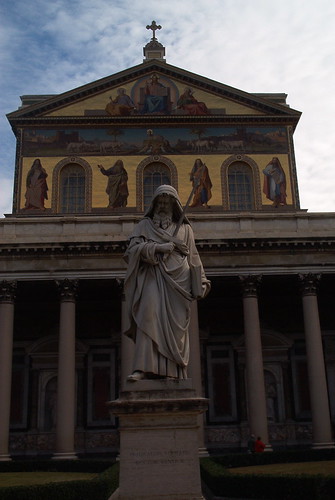
Basilica of St Paul Outside the Walls. Photo Tony Keen 2004.
The Basilica was originally built in the late fourth century, and was progressively modified by various Popes until a disastrous fire in 1823 destroyed most of the building. What is now there kept the floor plan of the pre-1823 building, but is built in a mid-nineteenth century architectural style. It's a bit naff in terms of decoration, but it is very impressive. Once inside, it doesn't take much to imagine it as a Roman basilica (Christian cathedrals took the much of the building form of the multi-purpose Roman halls), full of people busting about their business, with the local dignitary presiding over court proceedings or some such in the raised apse at the far end. Around the side is a collection of fragments from the original building, including some architectural features reused from even earlier buildings.
Then off for lunch, where Mum showed me photos she'd taken at various sites she'd been too. She took some nice photos, which she was good enough to give me a disk of, though sadly most of those in the Domus Aurea didn't come out very well.
After a flop, Mum, Kate and I headed out for the weekend walk which Kate made a New Year's Resolution to do (though we actually forgot that what we did was justified as this until we got back). I wanted to go again to Monte Testaccio. This is a little-visited site, but fascinating in its own way. In the second century BC, Rome moved its docklands area from by the Isola Tiberiana south to an area enclosed on three sides by a bend in the Tiber. This area became known as Emporium (a Latin term applied to a commercial port area). Among the imports offloaded here was olive oil. However, the Romans believed that the amphorae the olive oil came in, once emptied, could not be reused. So they broke them, and stacked them in neat rows in an area behind the wharves and warehouses. After several centuries, this resulted in a small hill, which is now, after a millennium and a half of erosion, about 35 m high. For the most part, the neat stacks have been broken and worn away at the surface of the hill, but on the north side there's a section where it's been restored, and you can see the amphorae fragments as they would have been. Mum took a nice photo of this.
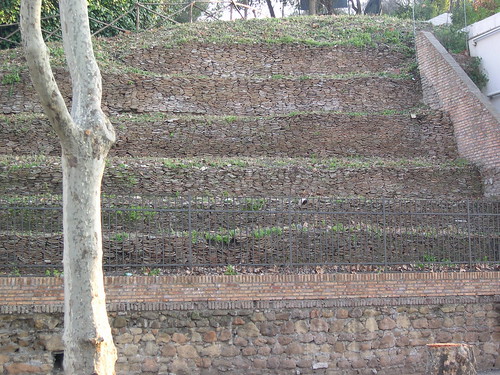
Monte Testaccio. Photo Ann Keen 2004.
From there, it's a short trip along another section of the Aurelian Wall to the Pyramid Monument of Gaius Cestius.

Monument of Cestius (l) and Porta Ostiense (r).
The Pyramid is the mad creation of Cestius, an important Roman of the first century BC. When he died, his slaves were freed under the terms of his will, and built the monument (presumably this was also part of the terms of the will). The gate to the right of the photo above is the Porta Ostiense, also called the Porta San Paolo, because the Via Ostiense, the road to Ostia, takes one past San Paolo fuori le Mura. This became cut off from the rest of the walls by traffic 'improvements' in the 1920s. There is a museum inside it, but I don't fancy your chances of getting to it!
Behind the photographer is the station from where the trains to Ostia depart. So it's a lovely place for me, with archaeology on one side, and trains on the other.
That did for Sunday, and I went to bed reading about the Roman Forum in the rather excellent guide (warning: this links to a page in Italian) the Soprintendenza Archeologica di Roma produce. These guides are well worth picking up if you're in Rome, and I learnt a lot from reading them. Occasionally, however, you can tell it's an Italian text translated into English, such as the point at which they mention a "circular square". In context it makes sense - 'square' is translating some Italian word for a public space.
Monday we had all day for sightseeing. We got to Termini, where we would leave our bags, by tram and bus. We avoided the train, partly because we weren't sure our all-day tickets would be valid (they would have been), and partly because we wanted to see a bit more of Rome.

A Roman Tram.
The No. 8 tram brings you to Largo Argentina (the name comes from a name given to a building by an important local dignitary, and has nothing to do with South American countries - a sign at the site gave the exact details, but I can't recall them now). Here we paused to look at the four Republican temples. These all sat in a row in front of the Portico of Pompey. It was in this Portico that Julius Caesar was murdered, though not necessarily (as my Mum thought the notice said) in the bit exposed by the excavation - in fact he was probably killed at the other end, by Pompey's theatre.
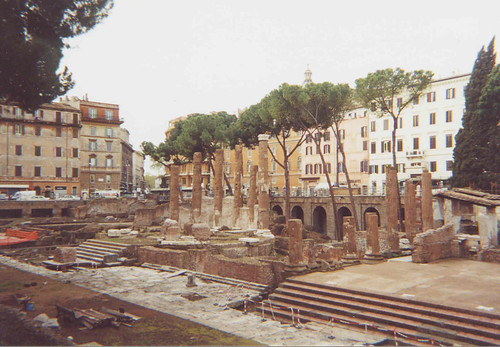
The four temples in the Area Sacra Argentina, with Temple D, so-called Temple of Juturna, nearest camera. Photo Ann Keen 2001.
From there, a bus led us around the Forum, around the backs of Trajan's Markets, and past the Baths of Diocletian, before depositing us at Termini. There I pointed out what remained of the walls of the Servian period (sixth century BC), walls Rome had outgrown by the early empire, the city being effectively unwalled from then until the time of Aurelian (AD 270-275).
We got a Metro to the Colosseum, which Kate particularly wanted to see (we went in after I'd been rude about the Arch of Constantine, which I find vulgar, not least because of the way it liberally steals its decorations from other monuments). I'd been in this three times before, so was able to give Kate a quick overview, before we prowled around. Then, in one of the arcades, we came across an exhibition called Nike, which was all about games and athletic competitions in the ancient world - we managed to go through it backwards. They had some famous artifacts there, such as the Hellenistic seated bronze boxer found in Rome, and two bronze runners from the Villa of the Papyri in Herculaneum, usually in the National Archeological Museum of Naples. But I was most interested in the graffiti from seats in the Colosseum. Here was the evidence of people whiling away the long days watching the gladiatorial fights, etc., by scratching pictures into the marble.
From there we had lunch; afterwards, Kate caught me out by asking what a building was. I didn't know. It was the Ludus Magnus, the training arena and barracks for the gladiators who fought in the Colosseum.

Ludus Magnus. Photo Kate Bodley 2005.
Then we went to the Forum, where I wanted to take photos of various buildings for my teaching. Kate very patiently followed me round and helped take photos, and then we headed out, via the Forum of Julius Caesar, and various other Imperial Fora, and back to Colosseo Metro station. Along the way, I noticed properly for the first time the back of the Basilica of Maxentius, which I'd never really looked at before. It's pretty impressive from the Forum side, but somehow it seems more so from the Via dei Fori Imperiali.
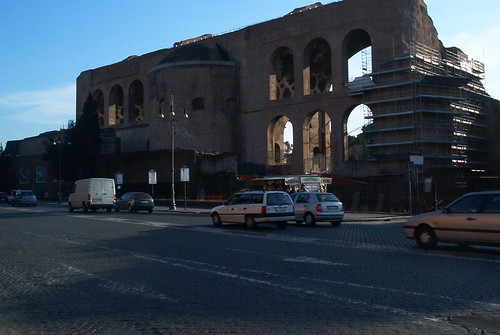
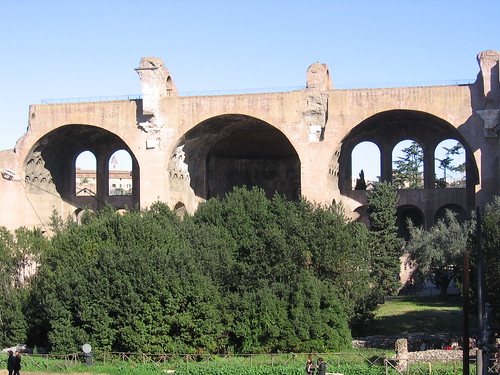
Basilica of Maxentius. Top: From Via dei Fori Imperiali. Photo Tony Keen 2004. Bottom: Facing the Via Sacra. Photo Tony Keen 2005.
From there we split up. Kate went shopping, whilst I went to the Ara Pacis. Unfortunately, this is still invisible, as they have not finished the new museum (it was meant to be completed in 2000), though the Mausoleum of Augustus is still to be seen. But left that, as I had a number of places I wanted to visit. First up was the Egyptian obelisk that stands outside the Palazzo di Montecitorio (where the Italian Parliament now sits). This had once been the pointer of Augustus' massive sundial in the Campus Martius. It wasn't too easy to get to, as I found my direct route closed off by the Italian police.
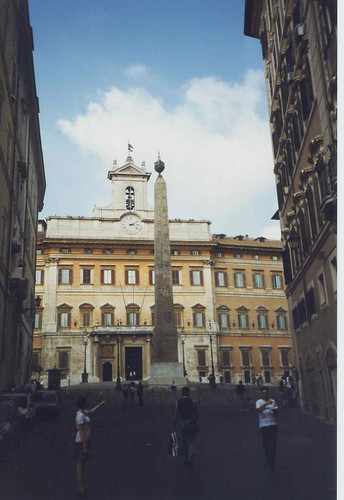
The Obelisk of Montecitorio. Photo Ann Keen 2001.
Then I headed back to the centre. I got distracted by a sign to the Pantheon, but though I found the Temple of the Deified Hadrian, which I hadn't seen before, I have to concede I got a bit lost. By the time I'd sorted myself out, I realized I had gone beyond the Pantheon. Time was now running out if I wasn't going to miss the bus to the airport. So I headed down the Forum Boarium, by the river, passing the Capitoline Hill and the replica equestrian statue of Marcus Aurelius on the way. Then to the Theatre of Marcellus, where I actually managed to get a decent photo. Unfortunately, most of the photos I'd taken with Kate's camera were too dark, as it was taking the light reading off the sky. But here I managed to block the sky out.
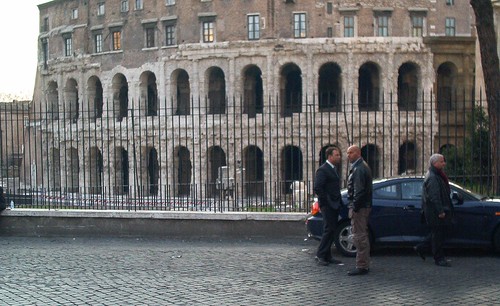
Theatre of Marcellus. Photo Tony Keen 2004.
I wandered down to the two temples of the Forum Boarium, among the oldest temples in Rome, and among the best preserved.
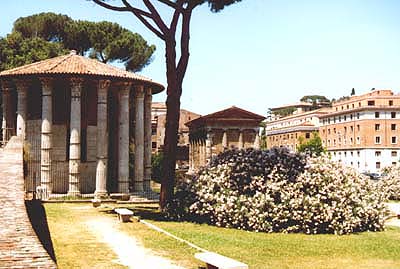
Temples of Hercules (l) and Portunus (r).
By now I was exhausted. I wandered to the bus stop, barely noticing the Bocca della Verita, an ancient drain cover now mounted in the portico of Santa Maria in Cosmedin. I waited for a bus. A bus didn't come. I started to flap. What if the bus didn't come? What if it took ages? What if it didn't come at all? I decided that i could probably walk to Termini in the time I had left, set off to do so, and then realized the smart thing to do was walk through the Circus Maximus back to the Metro. So I did that. The Circus is, as my Mum observed, not as impressive as you might expect. But it is less littered with discarded condoms than when I first came here in 1986.
And that was more-or-less it. The last ancient monument I saw was on the bus back to Ciampino, as we went out through yet another gate in the Aurelian Wall, this time going past the Amphitheatrum Castrense, a small, late amphitheatre that was later built into the wall, and its arches bricked up.
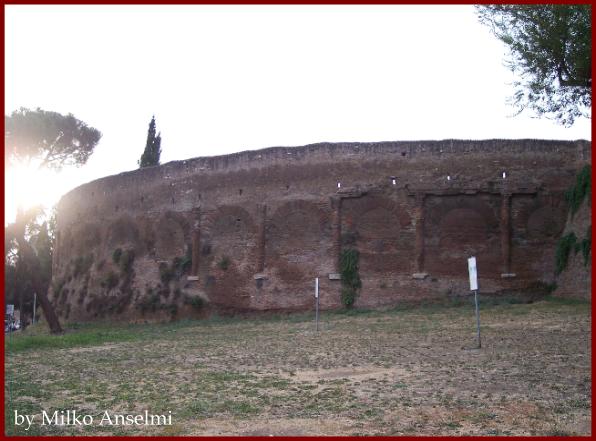
Amphitheatrum Castrense
I didn't see that much on this trip I hadn't seen before. But that was okay. Kate hadn't seen it. And we'll go back.
(Click on the photos without credits for sources and more information.)
No comments:
Post a Comment